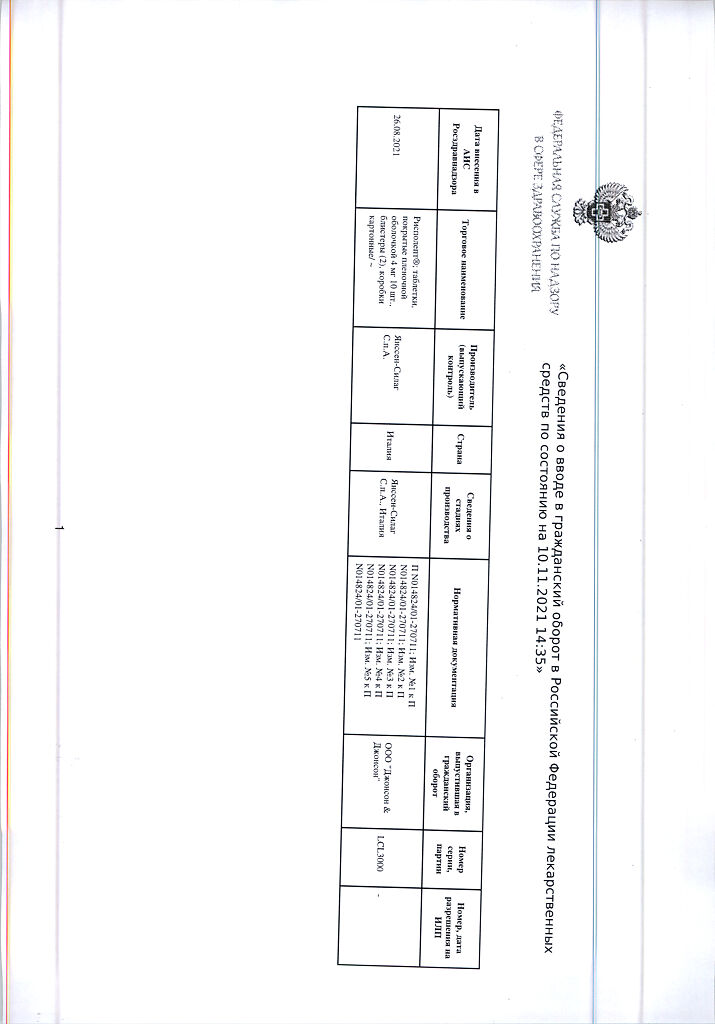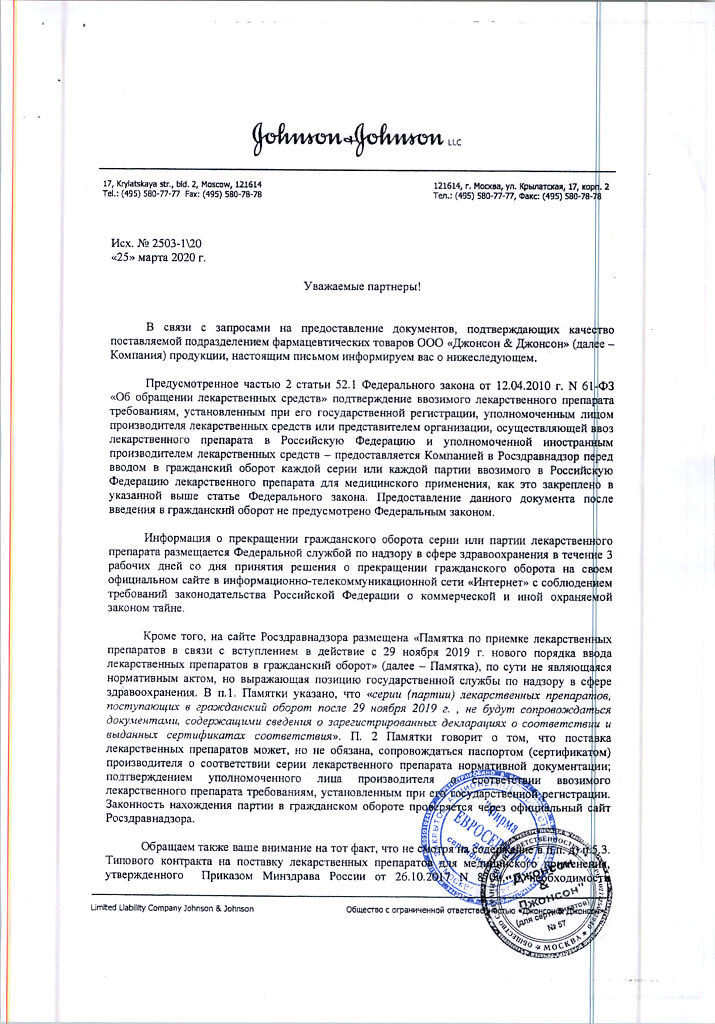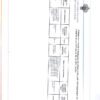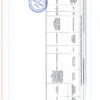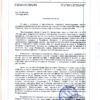No products in the cart.
Rispolettes, 4 mg 20 pcs.
€1.00
Out of stock
(E-mail when Stock is available)
Description
Rispolept is an antipsychotic drug, a benzisoxazole derivative. It also has sedative, antiemetic and hypothermic effects.
Risperidone is a selective monoaminergic antagonist with high affinity for serotonin 5-HT2- and dopamine D2-receptors. It binds to α1-adrenoceptors and somewhat weaker to histamine H1-receptors and α2-adrenoceptors. It has no tropism to cholinoreceptors.
Antipsychotic action is caused by blockade of dopamine D2-receptors of mesolimbic and mesocortical system. Sedative action is caused by blockade of adrenoreceptors of reticular formation of brain stem; antiemetic action – by blockade of dopamine D2-receptors of trigger zone of vomiting center; hypothermic action – by blockade of dopamine receptors of hypothalamus.
Risperidone reduces the productive symptomatology of schizophrenia (delirium, hallucinations), aggression, automatism, causes less suppression of motor activity and is less likely to induce catalepsy than classical neuroleptics. Balanced central antagonism to serotonin and dopamine may reduce the propensity for extrapyramidal side effects and extend the therapeutic effect of the drug on the negative and affective symptoms of schizophrenia.
Risperidone may cause a dose-dependent increase in plasma prolactin concentrations.
Pharmacokinetics
Intake
After oral administration, risperidone is completely absorbed from the GI tract. Cmax in plasma is reached after 1-2 hours. Food has no effect on absorption of the drug, so Rispolet can be prescribed regardless of meals.
Distribution
Risperidone is rapidly distributed in the body. The Vd is 1-2 l/kg. In plasma, risperidone binds to albumin and alpha1-glycoprotein. Risperidone binds 88% to plasma proteins, 9-hydroxy-risperidone – 77%.
The Css of risperidone in the body is reached within 1 day in most patients.
The Css of 9-hydroxy-risperidone is reached within 4-5 days. Plasma concentrations of risperidone are proportional to the dose of the drug (within therapeutic doses).
Metabolism
Risperidone is metabolized in the liver with the participation of CYP2D6 isoenzyme to form 9-hydroxy-risperidone, which has pharmacological effects similar to risperidone. Risperidone and 9-hydroxy-risperidone constitute the active antipsychotic fraction. Another route of metabolism of risperidone is N-dealkylation.
Elevation
After oral administration in patients with psychosis, the T1/2 of risperidone from plasma is about 3 hr. The T1/2 of 9-hydroxy-risperidone and the active antipsychotic fraction is 24 hours.
After a week of taking the drug, 70% of the dose is excreted in the urine, 14% in the feces. In the urine, risperidone plus 9-hydroxy-risperidone make up 35-45% of the dose. Inactive metabolites make up the rest.
Pharmacokinetics in Special Clinical Cases
In elderly patients and patients with renal impairment, higher plasma concentrations and delayed excretion of risperidone were observed after a single oral administration.
In patients with hepatic impairment plasma concentrations of risperidone did not change.
Indications
Indications
Relief of acute attacks and long-term maintenance therapy:
acute and chronic schizophrenia and other psychotic disorders with productive and negative symptoms;
affective disorders in various mental illnesses;
behavioral disorders in patients with dementia with symptoms of aggression (outbursts of anger, physical violence), disturbances in activity (agitation, delusions) or psychotic symptoms;
behavior disorders in adolescents over 15 years of age and adult patients with a reduced intellectual level or mental retardation in cases where destructive behavior (aggression, impulsivity, self-aggression) is leading in the clinical picture of the disease.
To stabilize mood in the treatment of mania in bipolar disorders (as an adjuvant therapy).
Pharmacological effect
Pharmacological effect
Rispolept is an antipsychotic drug, a derivative of benzisoxazole. It also has a sedative, antiemetic and hypothermic effect.
Risperidone is a selective monoaminergic antagonist with high affinity for serotonin 5-HT2 and dopamine D2 receptors. It binds to α1-adrenergic receptors and somewhat weaker to histamine H1-receptors and α2-adrenergic receptors. Does not have tropism for cholinergic receptors.
The antipsychotic effect is due to the blockade of dopamine D2 receptors in the mesolimbic and mesocortical systems. The sedative effect is due to the blockade of adrenergic receptors in the reticular formation of the brain stem; antiemetic effect – blockade of dopamine D2 receptors in the trigger zone of the vomiting center; hypothermic effect – blockade of dopamine receptors of the hypothalamus.
Risperidone reduces the productive symptoms of schizophrenia (delusions, hallucinations), aggressiveness, automatism, causes suppression of motor activity to a lesser extent and induces catalepsy to a lesser extent than classical antipsychotics. Balanced central antagonism of serotonin and dopamine may reduce the propensity for extrapyramidal side effects and enhance the drug’s therapeutic impact on negative and affective symptoms of schizophrenia.
Risperidone may cause a dose-dependent increase in plasma prolactin concentrations.
Pharmacokinetics
Suction
After oral administration, risperidone is completely absorbed from the gastrointestinal tract. Cmax in plasma is reached after 1-2 hours. Food does not affect the absorption of the drug, so Rispolept can be prescribed regardless of food intake.
Distribution
Risperidone is rapidly distributed in the body. Vd is 1-2 l/kg. In plasma, risperidone binds to albumin and alpha1-glycoprotein. Risperidone is 88% bound to plasma proteins, 9-hydroxy-risperidone is 77% bound.
Css of risperidone in the body in most patients is achieved within 1 day.
Css of 9-hydroxy-risperidone is achieved within 4-5 days. Plasma concentrations of risperidone are proportional to the dose of the drug (within therapeutic doses).
Metabolism
Risperidone is metabolized in the liver with the participation of the CYP2D6 isoenzyme with the formation of 9-hydroxy-risperidone, which has a pharmacological effect similar to risperidone. Risperidone and 9-hydroxy-risperidone constitute the active antipsychotic fraction. Another route of metabolism for risperidone is N-dealkylation.
Removal
After oral administration in patients with psychosis, T1/2 of risperidone from plasma is about 3 hours. T1/2 of 9-hydroxy-risperidone and the active antipsychotic fraction is 24 hours.
After a week of taking the drug, 70% of the dose is excreted in the urine, 14% in feces. In urine, risperidone plus 9-hydroxy-risperidone represents 35-45% of the dose. The remaining amount consists of inactive metabolites.
Pharmacokinetics in special clinical situations
In elderly patients and in patients with renal failure, higher plasma concentrations and slower elimination of risperidone were observed after a single oral dose.
In patients with liver failure, plasma risperidone concentrations did not change.
Special instructions
Special instructions
The drug should be used with caution in patients with diseases of the cardiovascular system (including heart failure, myocardial infarction, cardiac muscle conduction disorders), as well as in cases of dehydration, hypovolemia or cerebrovascular disorders. In this category of patients, the dose should be increased gradually.
The risk of developing orthostatic hypotension is especially increased in the initial period of dose selection. If hypotension occurs, dose reduction should be considered.
When using drugs that have the properties of dopamine receptor antagonists, the occurrence of tardive dyskinesia, characterized by involuntary rhythmic movements (mainly of the tongue and/or face), was noted. There are reports that the occurrence of extrapyramidal symptoms is a risk factor for the development of tardive dyskinesia. Rispolept causes the appearance of extrapyramidal symptoms to a lesser extent than classical antipsychotics. If symptoms of tardive dyskinesia occur, discontinuation of all antipsychotic medications should be considered.
When using classical antipsychotics, cases of NMS have been described, which is characterized by hyperthermia, muscle rigidity, instability of autonomic functions, disturbances of consciousness and increased levels of CPK. If NMS develops, it is necessary to discontinue all antipsychotic drugs, including Rispolept.
Rispolept should be prescribed with caution to patients with Parkinson’s disease, since theoretically it may worsen the course of this disease.
Classical antipsychotics are known to lower the seizure threshold. Considering this, Rispolept is recommended to be used with caution in patients with epilepsy.
Rispolept primarily affects the central nervous system, so it should be used with caution in combination with other centrally acting drugs.
During the treatment period, patients should be advised to refrain from overeating due to the possibility of weight gain.
Active ingredient
Active ingredient
Risperidone
Composition
Composition
Active ingredient:
risperidone;
Excipients:
lactose monohydrate;
cornstarch;
hypromellose 2910 (15 mPa s);
sodium lauryl sulfate;
MCC;
magnesium stearate;
colloidal silicon dioxide;
Film casing:
hypromellose 2910 (5 mPa s); propylene glycol; talc; titanium dioxide; dye “Sunset” yellow (E110); quinoline yellow dye (E104); indigo carmine (E132)
Pregnancy
Pregnancy
The safety of Rispolept in pregnant women has not been studied.
Rispolept can be used during pregnancy only if the positive effect justifies the possible risk.
Because risperidone and 9-hydroxy-risperidone are excreted in breast milk, women using Risperidone should not breast-feed.
Contraindications
Contraindications
lactation period (breastfeeding);
hypersensitivity to the components of the drug.
The drug should be used with caution in patients with diseases of the cardiovascular system (including chronic heart failure, previous myocardial infarction, conduction disorders), dehydration, hypovolemia, cerebrovascular accident, Parkinson’s disease, seizures (including a history), severe renal or liver failure, drug abuse or drug dependence, and conditions predisposing to the development of tachycardia of the “pirouette” type (bradycardia, electrolyte imbalance, concomitant use of drugs that prolong the QT interval), with brain tumors, intestinal obstruction, in cases of acute drug overdose, with Reye’s syndrome (since the antiemetic effect of risperidone can mask the symptoms of these conditions), during pregnancy, in patients under 15 years of age (since the safety and effectiveness of the drug have not been established).
Side Effects
Side Effects
From the side of the central nervous system: insomnia, agitation, anxiety, headache; sometimes – drowsiness, fatigue, dizziness, impaired concentration, blurred vision; rarely – extrapyramidal symptoms (tremor, rigidity, hypersalivation, bradykinesia, akathisia, acute dystonia). In patients with schizophrenia, hypervolemia (either due to polydipsia or due to the syndrome of inappropriate ADH secretion), tardive dyskinesia (involuntary rhythmic movements mainly of the tongue and/or face), NMS (hyperthermia, muscle rigidity, instability of autonomic functions, impaired consciousness and increased levels of CPK), thermoregulation disorders and convulsive seizures are possible.
From the digestive system: constipation, dyspepsia, nausea, vomiting, abdominal pain, increased activity of liver enzymes, dry mouth, hypo- or hypersalivation, anorexia, increased appetite, increased or decreased body weight.
From the cardiovascular system: orthostatic hypotension and reflex tachycardia, increased blood pressure. During treatment with Rispolept, the development of strokes has been described mainly in elderly patients with predisposing factors.
From the hematopoietic system: neutropenia, thrombocytopenia.
From the endocrine system: possible galactorrhea, gynecomastia, menstrual irregularities, amenorrhea; in isolated cases – the development of hyperglycemia or worsening of diabetes mellitus.
From the genitourinary system: priapism, erectile dysfunction, ejaculation disorders, anorgasmia, urinary incontinence.
Allergic reactions: rhinitis, skin rash, angioedema.
Dermatological reactions: dry skin, hyperpigmentation, itching, seborrhea, photosensitivity.
Other: arthralgia.
Interaction
Interaction
No special studies of drug interactions between Rispolept and other drugs have been conducted.
Rispolept can act as an antagonist of levodopa and dopamine agonists.
With the simultaneous use of Rispolept and carbamazepine, a decrease in the concentration of the active antipsychotic fraction of risperidone in plasma was observed. Similar effects may be observed with the use of other liver enzyme inducers. When discontinuing carbamazepine and other liver enzyme inducers, the dose of Rispolept should be reconsidered and, if necessary, reduced.
When used concomitantly with Rispolept, phenothiazines, tricyclic antidepressants and some beta-blockers may increase plasma concentrations of risperidone, but this does not affect the concentration of the active antipsychotic fraction.
When used simultaneously with Rispolept, fluoxetine may increase the plasma concentration of risperidone, but to a lesser extent the concentration of the active antipsychotic fraction.
When Rispolept is used simultaneously with other drugs with a high degree of binding to plasma proteins, there is no pronounced displacement of any drug from the plasma protein fraction, which manifests itself clinically.
Overdose
Overdose
Symptoms: drowsiness, manifestations of sedation, tachycardia, arterial hypotension, extrapyramidal symptoms. Up to 360 mg of the drug has been reported. The data obtained suggest a wide range of drug safety. In rare cases, an overdose has been associated with a prolongation of the QT interval.
In case of acute overdose during combination therapy, the possibility of involvement of other drugs should be analyzed.
Treatment: The airway should be kept open to ensure adequate oxygen supply and ventilation. Gastric lavage is indicated (after intubation, if the patient is unconscious) and the administration of activated charcoal along with a laxative. ECG monitoring should be started immediately to identify possible heart rhythm disturbances.
There is no specific antidote; appropriate symptomatic therapy should be carried out. In case of arterial hypotension and vascular collapse, intravenous infusion solutions and/or sympathomimetic drugs should be used. If acute extrapyramidal symptoms develop, anticholinergic drugs should be prescribed. Constant medical observation and monitoring should be continued until symptoms of intoxication disappear.
Storage conditions
Storage conditions
In a place protected from light, at a temperature of 15–30 °C
Shelf life
Shelf life
3 years
Manufacturer
Manufacturer
Janssen-Cilag S.p.A., Italy
Additional information
| Shelf life | 3 years |
|---|---|
| Conditions of storage | In a light-protected place at 15-30 °C |
| Manufacturer | Janssen-Silag S.p.A., Italy |
| Medication form | pills |
| Brand | Janssen-Silag S.p.A. |
Related products
Buy Rispolettes, 4 mg 20 pcs. with delivery to USA, UK, Europe and over 120 other countries.


